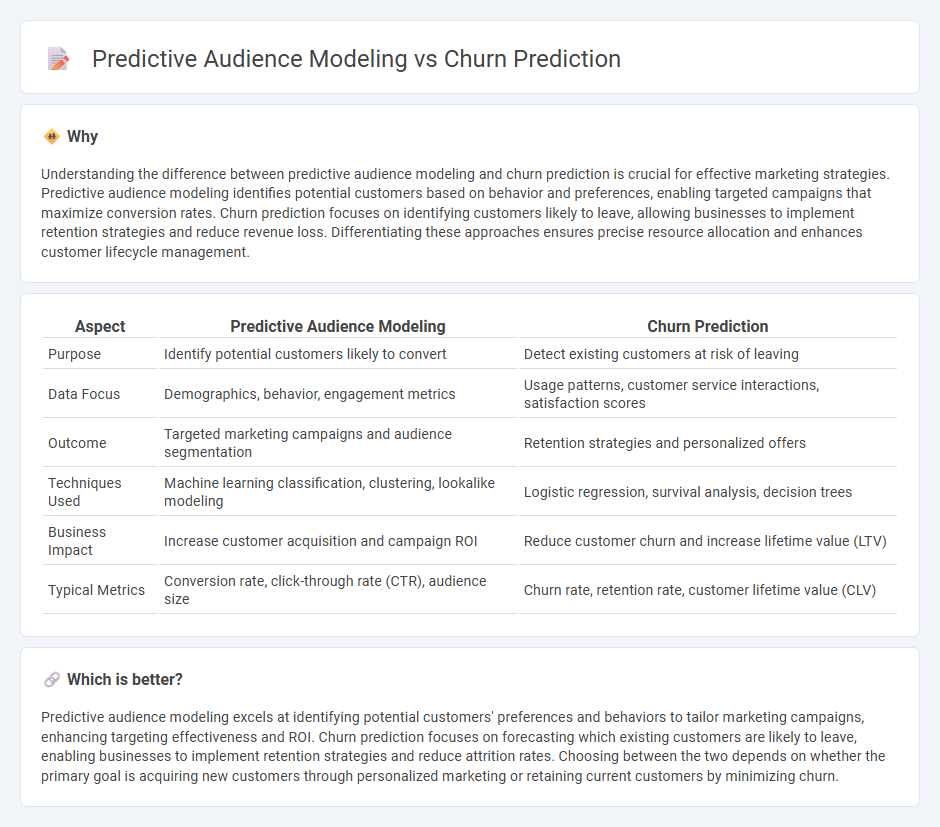
Predictive audience modeling employs machine learning algorithms to identify and segment potential customers based on behavior patterns, enhancing targeted marketing strategies and optimizing ad spend. Churn prediction focuses on analyzing customer data to forecast which users are likely to discontinue using a service, enabling proactive retention efforts and reducing revenue loss. Explore these advanced marketing techniques to boost customer acquisition and loyalty effectively.
Why it is important
Understanding the difference between predictive audience modeling and churn prediction is crucial for effective marketing strategies. Predictive audience modeling identifies potential customers based on behavior and preferences, enabling targeted campaigns that maximize conversion rates. Churn prediction focuses on identifying customers likely to leave, allowing businesses to implement retention strategies and reduce revenue loss. Differentiating these approaches ensures precise resource allocation and enhances customer lifecycle management.
Comparison Table
| Aspect | Predictive Audience Modeling | Churn Prediction |
|---|---|---|
| Purpose | Identify potential customers likely to convert | Detect existing customers at risk of leaving |
| Data Focus | Demographics, behavior, engagement metrics | Usage patterns, customer service interactions, satisfaction scores |
| Outcome | Targeted marketing campaigns and audience segmentation | Retention strategies and personalized offers |
| Techniques Used | Machine learning classification, clustering, lookalike modeling | Logistic regression, survival analysis, decision trees |
| Business Impact | Increase customer acquisition and campaign ROI | Reduce customer churn and increase lifetime value (LTV) |
| Typical Metrics | Conversion rate, click-through rate (CTR), audience size | Churn rate, retention rate, customer lifetime value (CLV) |
Which is better?
Predictive audience modeling excels at identifying potential customers' preferences and behaviors to tailor marketing campaigns, enhancing targeting effectiveness and ROI. Churn prediction focuses on forecasting which existing customers are likely to leave, enabling businesses to implement retention strategies and reduce attrition rates. Choosing between the two depends on whether the primary goal is acquiring new customers through personalized marketing or retaining current customers by minimizing churn.
Connection
Predictive audience modeling analyzes customer data to identify patterns that forecast future behaviors, while churn prediction specifically estimates the likelihood of customers discontinuing use of a product or service. By integrating predictive audience modeling with churn prediction, marketers can segment high-risk customers and tailor retention strategies to reduce attrition rates. Leveraging machine learning algorithms on demographic, behavioral, and transactional data enhances accuracy in targeting audiences prone to churn and improves customer lifetime value.
Key Terms
**Churn Prediction:**
Churn prediction uses machine learning algorithms and historical customer data to identify individuals at high risk of leaving a service, enabling targeted retention strategies and reducing revenue loss. Common techniques include logistic regression, decision trees, and neural networks, which analyze customer behavior patterns, transaction histories, and engagement metrics. Discover how advanced churn prediction models can enhance customer loyalty and optimize marketing efforts.
Retention Rate
Churn prediction leverages customer behavior data and machine learning algorithms to identify individuals at risk of leaving, enhancing retention rate by enabling targeted interventions. Predictive audience modeling segments potential customers based on purchasing patterns and demographic data to optimize retention strategies and increase lifetime value. Explore how combining these techniques can boost your customer retention rate effectively.
Customer Lifetime Value (CLV)
Churn prediction identifies customers likely to discontinue engagement, enabling proactive retention strategies that directly impact Customer Lifetime Value (CLV). Predictive audience modeling segments customers based on future behaviors, optimizing marketing efforts to enhance CLV across varied demographics. Explore advanced techniques to elevate your customer retention and value maximization strategies.
Source and External Links
Mastering Churn Prediction: Strategies for Improved Customer ... - Churn prediction uses historical customer data and behavior patterns to identify customers likely to stop using a product or cancel subscriptions, enabling targeted retention actions and alignment of product and marketing strategies.
Research on customer churn prediction and model interpretability ... - Advanced churn prediction models like GA-XGBoost combine genetic algorithms and XGBoost with data balancing techniques such as SMOTEENN to achieve high accuracy (96%) and recall (92%) in predicting customer churn, especially in banking.
Churn prediction explained | Stripe - Effective churn prediction relies on collecting and integrating comprehensive, quality data from various sources like transactions, customer interactions, and social media, plus cleansing data and respecting privacy regulations, to create actionable customer insights.
 dowidth.com
dowidth.com